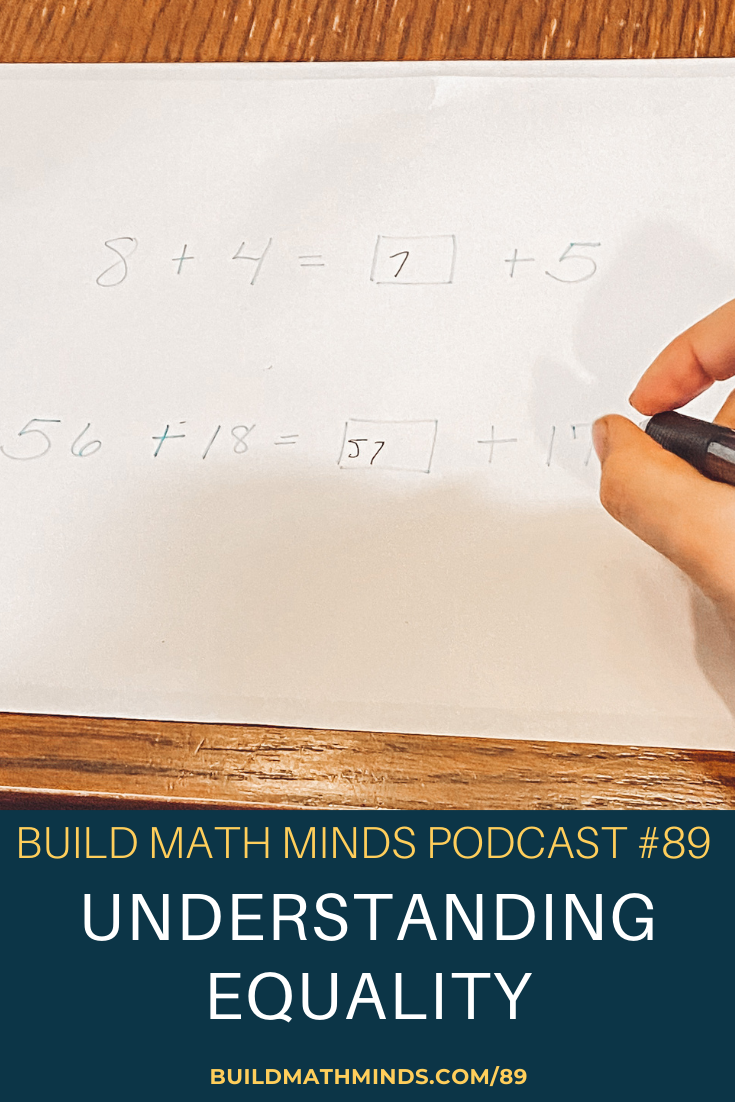Resources mentioned in this episode:
Thinking Mathematically: Integrating Arithmetic & Algebra in Elementary School by Thomas P. Carpenter, Megan Loef Franke, and Linda Levi
The Flexibility Formula courses
Welcome fellow Recovering Traditionalists to Episode 89. Today we are taking a look at Understanding Equality.
If you’ve been around here for awhile you know I love Cognitively Guided Instruction and you’ve heard me talk about the book Children’s Mathematics. But did you know that some of the authors of that book also wrote a book called Thinking Mathematically?
This book was a huge eye-opener for me around students’ understanding and really their misunderstandings about equality and especially the equal sign. On page 9, they ask:
“How would the students in your class respond to the following question:
What number would you put in the box to make this a true number sentence?
8 + 4 = ▢ + 5”
We would think kids would put 7 in the box, but the majority of kids in grades 1 – 6 did not. In fact the most common response was 12. What was interesting to me was that more 1st and 2nd graders responded with the correct answer of 7 than 5th and 6th graders.
The reason kids got the incorrect answers had nothing to do with their ability to add and subtract. It has to do with their understanding of the equal sign.
Twelve was the most common answer because when kids see the equal sign they think it means “the answer comes next.” 8 + 4 is 12, so the 12 goes after the equal sign. But the equal sign is showing the relationship between what’s on one side of the sign to what’s on the other side. So think about when you put the greater than or less than signs in, those symbols denote the relationship between the quantities. The equal sign does as well, but the relationship is not that one is more or less than the other, instead the quantities are the same.
But how do we help kids understand what the equal sign means? On pages 14-15 they write:
“We have found that it is most fruitful to engage students in a discussion of the equal sign in the context of specific tasks. Appropriately chosen tasks can (a) provide a focus for students to articulate their ideas, (b) challenge students’ conceptions by providing different contexts in which they need to examine the positions they have staked out, and (c) provide a window on children’s thinking. True/False and open number sentences have proven particularly productive as a context for discussing equality. These number sentences can be manipulated in a variety of ways to create situations that may challenge students’ conceptions and provide a context for discussion.”
In case you aren’t sure what True/False and open number sentences are, here’s an example of each:
Is the number sentence 6 = 5 + 1 True or False?
3 + 5 = ▢ + 3 is an example of an Open Number Sentence.
But there is so much more that goes into using these things in your classroom than just giving them to the students and asking them to solve. It’s about the discussion that happens and hearing how kids think about it. So as always, I recommend you get the book so you can learn how to do them in your classroom.
The book also goes into more detail than just helping kids understand the equal sign in order to help them understand equality and develop their algebraic thinking. We tend to think algebraic thinking is something only older kids can do. However, this book opened my eyes to all the things we can be doing in the elementary grades to help move kids away from computational thinking and into relational thinking, which is a foundation of algebraic reasoning.
Subscribe and Review in iTunes
Hey, are you subscribed to the Build Math Minds Podcast, yet? If you’re not, make sure to do that today because I don’t want you to miss any episodes! Click here to subscribe to the podcast in iTunes.
While you’re there, don’t forget to leave a review on iTunes too. I would love to know your thoughts and how we can make sure that we give you content that you will really enjoy.
To leave a review, head over to iTunes and click on “Ratings and Reviews” and “Write a Review.” I can’t wait to hear your thoughts about the podcast.




